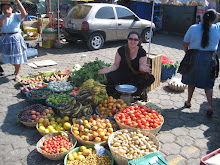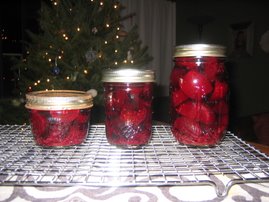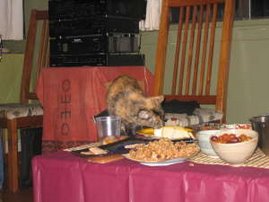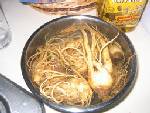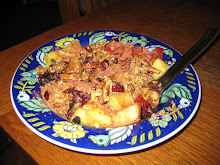 After Christmas last year, we spent a week at our friends' country house in Pennsylvania. We usually go and stock up on buffalo meat from the buffalo farm about forty-five minutes away. A few times, we decided to stop at an antique store called The Glass Hat, where we found this amazing lamp. It took us a few months to decide whether we wanted to plunk down so much money for it, but even when money is tight, we never regret buying this oil lamp from the 1880s. We don't light it very often, but when we do, it makes any meal feel really special. We lit it for St. Patrick's Day this year.
After Christmas last year, we spent a week at our friends' country house in Pennsylvania. We usually go and stock up on buffalo meat from the buffalo farm about forty-five minutes away. A few times, we decided to stop at an antique store called The Glass Hat, where we found this amazing lamp. It took us a few months to decide whether we wanted to plunk down so much money for it, but even when money is tight, we never regret buying this oil lamp from the 1880s. We don't light it very often, but when we do, it makes any meal feel really special. We lit it for St. Patrick's Day this year.  Our meal only looks like it took a lot of work, but it didn't. The weekend before, we picked up a brined brisket from Trader Joe's (I meant to make my own this year, but . . . well, next year). I stuck that in a crock pot with some Guinness Beer, carrots, and onions this morning and let it cook for 8 hours. Then I boiled cabbage with caraway sees, heated up some aging carrot puree, and baked some sliced baby potatoes with olive oil, salt, pepper, and chopped rosemary.
Our meal only looks like it took a lot of work, but it didn't. The weekend before, we picked up a brined brisket from Trader Joe's (I meant to make my own this year, but . . . well, next year). I stuck that in a crock pot with some Guinness Beer, carrots, and onions this morning and let it cook for 8 hours. Then I boiled cabbage with caraway sees, heated up some aging carrot puree, and baked some sliced baby potatoes with olive oil, salt, pepper, and chopped rosemary. The most unique thing about this year's meal was the whole wheat soda bread. I found a recipe that claimed to produce little confetti shamrocks when you sliced the bread. And it did! The sunflower seeds react somehow to the dough when it sits and then bakes in such a way that the seeds turn green! Totally fun. And it was very tasty. I will definitely make this bread again next year.
Shamrock Soda Bread
1 3/4 cups unbleached all-purpose flour
1 cup whole wheat flour or graham flour, plus more for shaping
3 tablespoons cold unsalted butter, cut into tablespoon-sized pieces
2 teaspoons baking soda
1 3/4 teaspoons salt
2 tablespoons granulated sugar
1/4 cup wheat bran
1/4 cup oat bran
1/4 cup untoasted wheat germ
2 tablespoons flaxseed
1/3 cup raw sunflower seeds
1 large egg
About 1 3/4 cups buttermilk
 Adjust an oven rack to the center position and preheat the oven to 425°F. Coat a heavy baking sheet with vegetable cooking spray or line it with a silicone baking pan liner or aluminum foil.In a large bowl, stir together the all-purpose flour and whole wheat flour. Add the butter and work it into the dry ingredients with your fingertips until the fat particles are very fine. Stir in the baking soda, salt, sugar, wheat bran, oat bran, wheat germ, flaxseed, and sunflower seeds. Beat the egg lightly with a fork in a 2-cup glass measure. Add enough buttermilk to come to the 2-cup line and stir with the fork to combine well. Add the liquid to the dry ingredients and stir with a wooden spoon or rubber spatula until the dough gathers into a thick, wet-looking mass.
Adjust an oven rack to the center position and preheat the oven to 425°F. Coat a heavy baking sheet with vegetable cooking spray or line it with a silicone baking pan liner or aluminum foil.In a large bowl, stir together the all-purpose flour and whole wheat flour. Add the butter and work it into the dry ingredients with your fingertips until the fat particles are very fine. Stir in the baking soda, salt, sugar, wheat bran, oat bran, wheat germ, flaxseed, and sunflower seeds. Beat the egg lightly with a fork in a 2-cup glass measure. Add enough buttermilk to come to the 2-cup line and stir with the fork to combine well. Add the liquid to the dry ingredients and stir with a wooden spoon or rubber spatula until the dough gathers into a thick, wet-looking mass.Sprinkle your work surface with whole wheat flour and scrape the dough onto it. Dust the dough with a bit more whole wheat flour. Pat the dough into a circular shape about 7 inches across and 2 inches high and transfer it to the prepared baking sheet. Don't be concerned about evenness—the loaf should look rustic. Make a cross-shaped indentation on top of the loaf going right to the edges. I use a plastic bench scraper and press it into the dough very gently; don't actually cut the dough. During baking the indentation expands, giving the top of the loaf an attractive pattern.
Bake the bread for about 40 minutes, until it is well browned and sounds hollow when rapped on the bottom. An instant-read thermometer inserted into the center of the loaf should register 195° to 200°F. Cool the loaf on a wire cooling rack, and serve warm or at room temperature. Cut into quarters and slice each quarter with a sharp serrated knife. Delicious with butter.
h




